2004 ISUZU TF SERIES wiring
[x] Cancel search: wiringPage 2753 of 4264
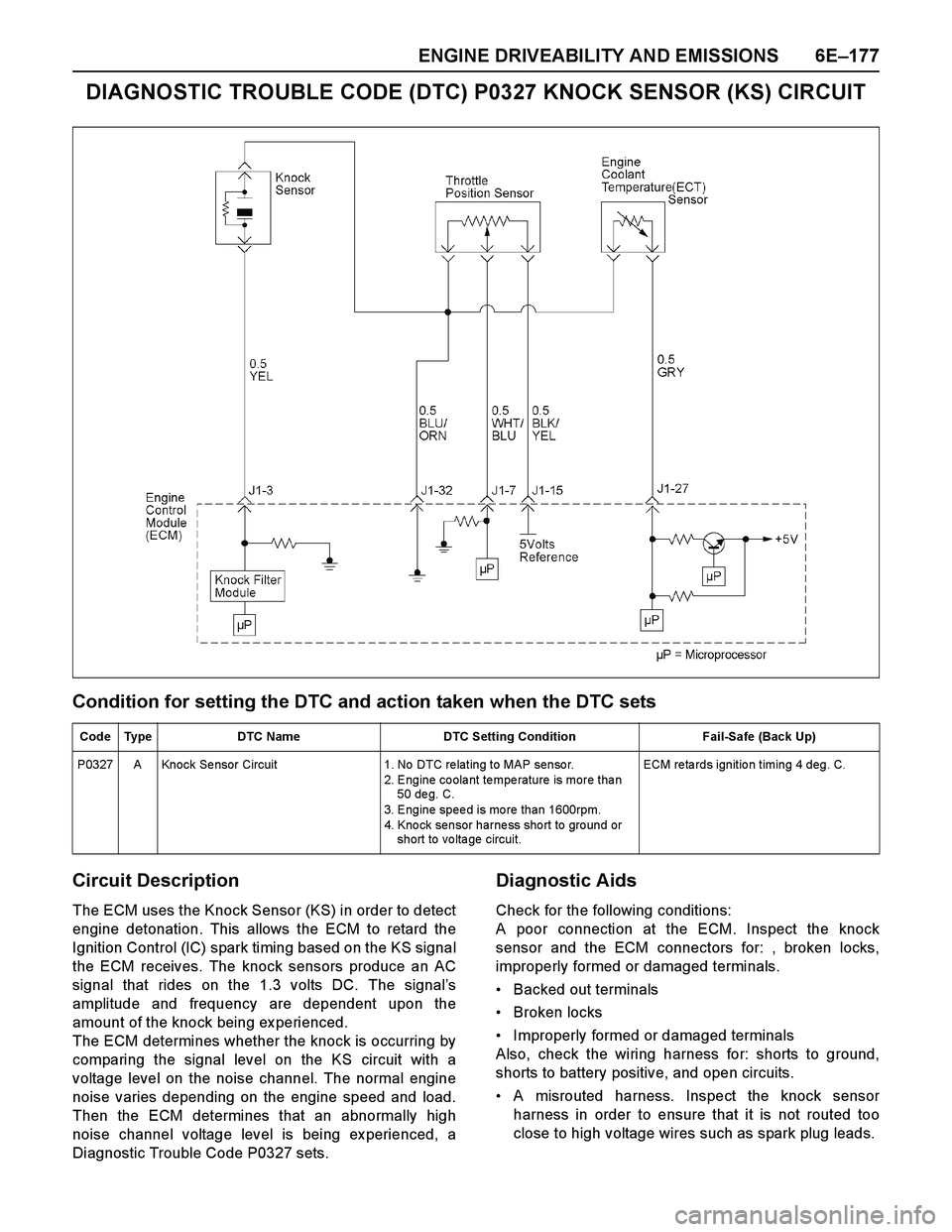
ENGINE DRIVEABILITY AND EMISSIONS 6E–177
DIAGNOSTIC TROUBLE CODE (DTC) P0327 KNOCK SENSOR (KS) CIRCUIT
Condition for setting the DTC and action taken when the DTC sets
Circuit Description
The ECM uses the Knock Sensor (KS) in order to detect
engine detonation. This allows the ECM to retard the
Ignition Control (IC) spark timing based on the KS signal
the ECM receives. The knock sensors produce an AC
signal that rides on the 1.3 volts DC. The signal’s
amplitude and frequency are dependent upon the
amount of the knock being ex perienced.
The ECM determines whether the knock is occurring by
comparing the signal level on the KS circuit with a
voltage level on the noise channel. The normal engine
noise varies depending on the engine speed and load.
Then the ECM determines that an abnormally high
noise channel voltage level is being ex perienced, a
Diagnostic Trouble Code P0327 sets.
Diagnostic Aids
Check for the following conditions:
A poor connection at the ECM. Inspect the knock
sensor and the ECM connectors for: , broken locks,
improperly formed or damaged terminals.
Backed out terminals
Broken locks
Improperly formed or damaged terminals
Also, check the wiring harness for: shorts to ground,
shorts to battery positive, and open circuits.
A misrouted harness. Inspect the knock sensor
harness in order to ensure that it is not routed too
close to high voltage wires such as spark plug leads.
Code Type DTC Name DTC Setting Condition Fail-Safe (Back Up)
P0327 A Knock Se nsor Circuit 1. No DTC re lating to MAP senso r.
2. Engine coolant temperature is more than
50 de g. C.
3. Engine speed is more than 1600rpm.
4. Knock sensor harness short to ground or
short to vo lta ge circuit.ECM re ta rds ignitio n timing 4 deg. C.
Page 2757 of 4264
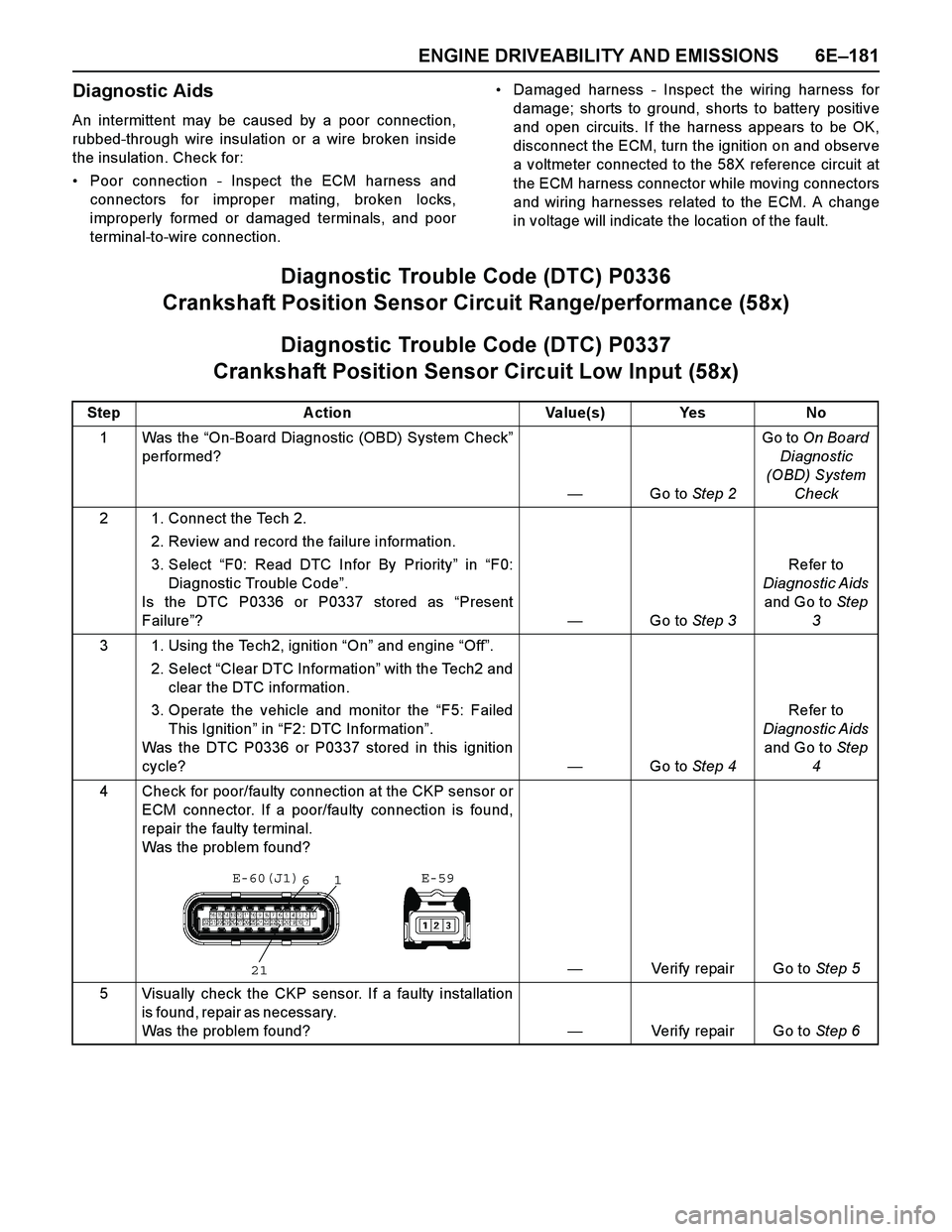
ENGINE DRIVEABILITY AND EMISSIONS 6E–181
Diagnostic Aids
An intermittent may be caused by a poor connection,
rubbed-through wire insulation or a wire broken inside
the insulation. Check for:
Poor connection - Inspect the ECM harness and
connectors for improper mating, broken locks,
improperly formed or damaged terminals, and poor
terminal-to-wire connection.Damaged harness - Inspect the wiring harness for
damage; shorts to ground, shorts to battery positive
and open circuits. If the harness appears to be OK,
disconnect the ECM, turn the ignition on and observe
a voltmeter connected to the 58X reference circuit at
the ECM harness connector while moving connectors
and wiring harnesses related to the ECM. A change
in voltage will indicate the location of the fault.
Diagnostic Trouble Code (DTC) P0336
Crankshaft Position Sensor Circuit Range/performance (58x)
Diagnostic Trouble Code (DTC) P0337
Crankshaft Position Sensor Circuit Low Input (58x)
Step A ction Value(s) Yes No
1 Was the “On-Board Diagnostic (OBD) System Check”
performed?
—Go to Step 2Go to On Board
Diagnostic
(OBD) System
Check
2 1. Connect the Tech 2.
2. Review and record the failure information.
3. Select “F0: Read DTC Infor By Priority” in “F0:
Diagnostic Trouble Code”.
Is the DTC P0336 or P0337 stored as “Present
Failure”?—Go to Step 3Refer to
Diagnostic Aids
and Go to Step
3
3 1. Using the Tech2, ignition “On” and engine “Off”.
2. Select “Clear DTC Information” with the Tech2 and
clear the DTC information.
3. Operate the vehicle and monitor the “F5: Failed
This Ignition” in “F2: DTC Information”.
Was the DTC P0336 or P0337 stored in this ignition
cycle?—Go to Step 4Refer to
Diagnostic Aids
and Go to Step
4
4 Check for poor/faulty connection at the CKP sensor or
ECM connector. If a poor/faulty connection is found,
repair the faulty terminal.
Was the problem found?
—Verify repair Go to Step 5
5 Visually check the CKP sensor. If a faulty installation
is found, repair as necessary.
Was the problem found? —Verify repair Go to Step 6
21
61 E-60(J1) E-59
Page 2763 of 4264
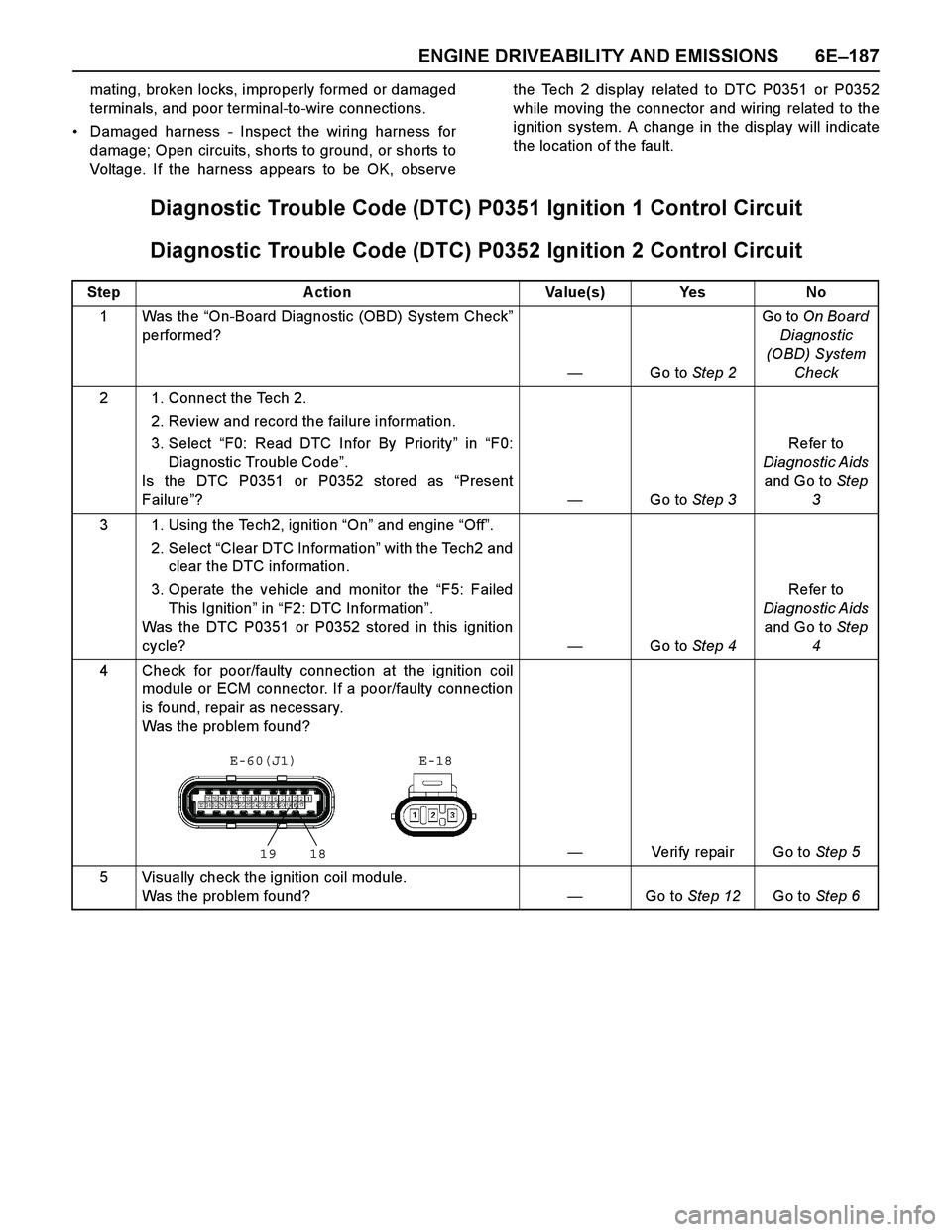
ENGINE DRIVEABILITY AND EMISSIONS 6E–187
mating, broken locks, improperly formed or damaged
terminals, and poor terminal-to-wire connections.
Damaged harness - Inspect the wiring harness for
damage; Open circuits, shorts to ground, or shorts to
Voltage. If the harness appears to be OK, observethe Tech 2 display related to DTC P0351 or P0352
while moving the connector and wiring related to the
ignition system. A change in the display will indicate
the location of the fault.
Diagnostic Trouble Code (DTC) P0351 Ignition 1 Control Circuit
Diagnostic Trouble Code (DTC) P0352 Ignition 2 Control Circuit
Step A ction Value(s) Yes No
1 Was the “On-Board Diagnostic (OBD) System Check”
performed?
—Go to Step 2Go to On Board
Diagnostic
(OBD) System
Check
2 1. Connect the Tech 2.
2. Review and record the failure information.
3. Select “F0: Read DTC Infor By Priority” in “F0:
Diagnostic Trouble Code”.
Is the DTC P0351 or P0352 stored as “Present
Failure”?—Go to Step 3Refer to
Diagnostic Aids
and Go to Step
3
3 1. Using the Tech2, ignition “On” and engine “Off”.
2. Select “Clear DTC Information” with the Tech2 and
clear the DTC information.
3. Operate the vehicle and monitor the “F5: Failed
This Ignition” in “F2: DTC Information”.
Was the DTC P0351 or P0352 stored in this ignition
cycle?—Go to Step 4Refer to
Diagnostic Aids
and Go to Step
4
4 Check for poor/faulty connection at the ignition coil
module or ECM connector. If a poor/faulty connection
is found, repair as necessary.
Was the problem found?
—Verify repair Go to Step 5
5 Visually check the ignition coil module.
Was the problem found?—Go to Step 12Go to Step 6
19 18
E-60(J1) E-18
Page 2791 of 4264
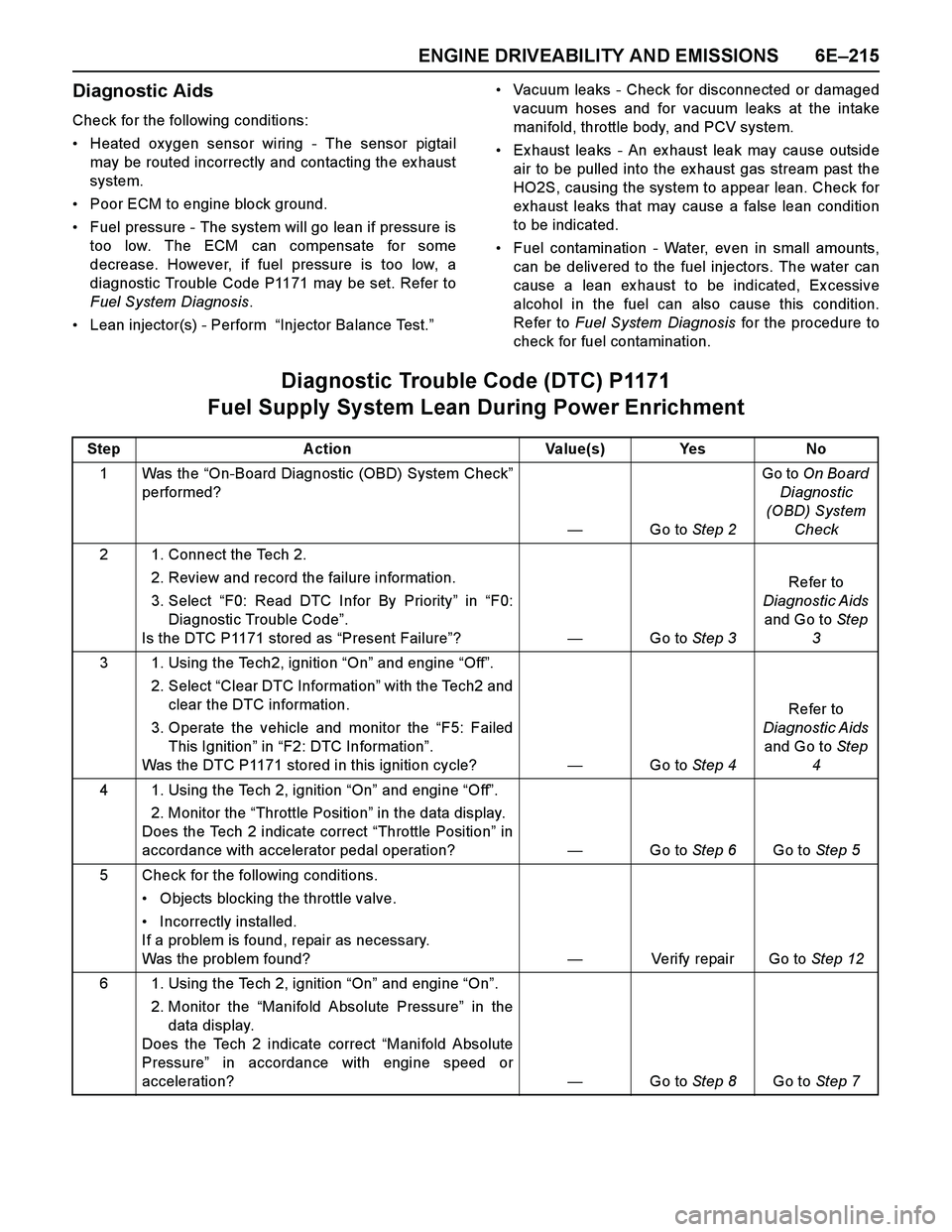
ENGINE DRIVEABILITY AND EMISSIONS 6E–215
Diagnostic Aids
Check for the following conditions:
Heated oxygen sensor wiring - The sensor pigtail
may be routed incorrectly and contacting the ex haust
system.
Poor ECM to engine block ground.
Fuel pressure - The system will go lean if pressure is
too low. The ECM can compensate for some
decrease. However, if fuel pressure is too low, a
diagnostic Trouble Code P1171 may be set. Refer to
Fuel System Diagnosis.
Lean injector(s) - Perform “Injector Balance Test.”Vacuum leaks - Check for disconnected or damaged
vacuum hoses and for vacuum leaks at the intake
manifold, throttle body, and PCV system.
Ex haust leaks - An ex haust leak may cause outside
air to be pulled into the ex haust gas stream past the
HO2S, causing the system to appear lean. Check for
exhaust leaks that may cause a false lean condition
to be indicated.
Fuel contamination - Water, even in small amounts,
can be delivered to the fuel injectors. The water can
cause a lean ex haust to be indicated, Ex cessive
alcohol in the fuel can also cause this condition.
Refer to Fuel System Diagnosis for the procedure to
check for fuel contamination.
Diagnostic Trouble Code (DTC) P1171
Fuel Supply Sy stem Lean During Power Enrichment
Step A ction Value(s) Yes No
1 Was the “On-Board Diagnostic (OBD) System Check”
performed?
—Go to Step 2Go to On Board
Diagnostic
(OBD) System
Check
2 1. Connect the Tech 2.
2. Review and record the failure information.
3. Select “F0: Read DTC Infor By Priority” in “F0:
Diagnostic Trouble Code”.
Is the DTC P1171 stored as “Present Failure”?—Go to Step 3Refer to
Diagnostic Aids
and Go to Step
3
3 1. Using the Tech2, ignition “On” and engine “Off”.
2. Select “Clear DTC Information” with the Tech2 and
clear the DTC information.
3. Operate the vehicle and monitor the “F5: Failed
This Ignition” in “F2: DTC Information”.
Was the DTC P1171 stored in this ignition cycle?—Go to Step 4Refer to
Diagnostic Aids
and Go to Step
4
4 1. Using the Tech 2, ignition “On” and engine “Off”.
2. Monitor the “Throttle Position” in the data display.
Does the Tech 2 indicate correct “Throttle Position” in
accordance with accelerator pedal operation? —Go to Step 6Go to Step 5
5 Check for the following conditions.
Objects blocking the throttle valve.
Incorrectly installed.
If a problem is found, repair as necessary.
Was the problem found?—Verify repair Go to Step 12
6 1. Using the Tech 2, ignition “On” and engine “On”.
2. Monitor the “Manifold Absolute Pressure” in the
data display.
Does the Tech 2 indicate correct “Manifold Absolute
Pressure” in accordance with engine speed or
acceleration? —Go to Step 8Go to Step 7
Page 2794 of 4264

6E–218 ENGINE DRIVEABILITY AND EMISSIONS
DIAGNOSTIC TROUBLE CODE (DTC) P1626 IMMOBILIZER NO SIGNAL
Condition for setting the DTC and action taken when the DTC sets
Circuit Description
The ECM decides whether that is an abnomality in the
immobilizer control system. DTC P1626 is recorded by
the ECM when no response from immobiliser.
Diagnostic Aids
Check for the following conditions:
Poor connection at ECM and Immobilizer-Inspect
harness connectors for backed out terminals,
improper mating, broken locks, improperly formed ordamaged terminals, and poor terminal to wire
connection.
Damaged harness Inspect the wiring harness for
damage, If the harness appears to be OK, disconnect
the ECM and Immobilizer, turn the ignition “ON” and
observe a voltmeter connected to the suspect driver
circuit at the ECM and Immobilizer harnass connector
while moving connectors and wiring harnesses
relates to the MIL. A change in voltage will indicate
the location of the fault.
Code Type DTC Name DTC Setting Condition Fail-Safe (Back Up)
P1626 - Immobilizer No Signal No response from immobilizer control unit. 1. Engine does not start.
2. Check engine lamp flash.
Page 2798 of 4264
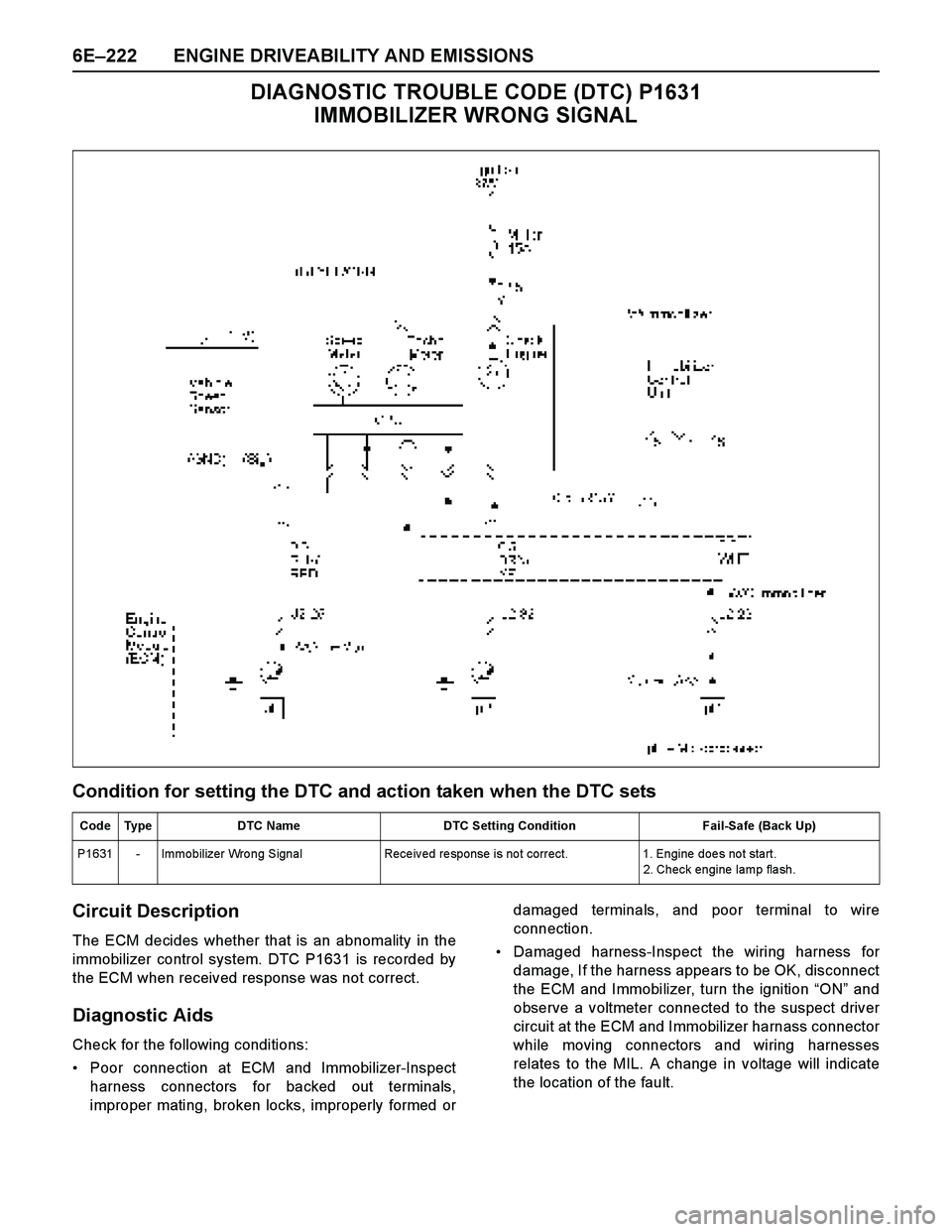
6E–222 ENGINE DRIVEABILITY AND EMISSIONS
DIAGNOSTIC TROUBLE CODE (DTC) P1631
IMMOBILIZER WRONG SIGNAL
Condition for setting the DTC and action taken when the DTC sets
Circuit Description
The ECM decides whether that is an abnomality in the
immobilizer control system. DTC P1631 is recorded by
the ECM when received response was not correct.
Diagnostic Aids
Check for the following conditions:
Poor connection at ECM and Immobilizer-Inspect
harness connectors for backed out terminals,
improper mating, broken locks, improperly formed ordamaged terminals, and poor terminal to wire
connection.
Damaged harness-Inspect the wiring harness for
damage, If the harness appears to be OK, disconnect
the ECM and Immobilizer, turn the ignition “ON” and
observe a voltmeter connected to the suspect driver
circuit at the ECM and Immobilizer harnass connector
while moving connectors and wiring harnesses
relates to the MIL. A change in voltage will indicate
the location of the fault.
Code Type DTC Name DTC Setting Condition Fail-Safe (Back Up)
P1631 - Immobilizer Wrong Signal Received response is not correct. 1. Engine does not start.
2. Check engine lamp flash.
Page 2800 of 4264
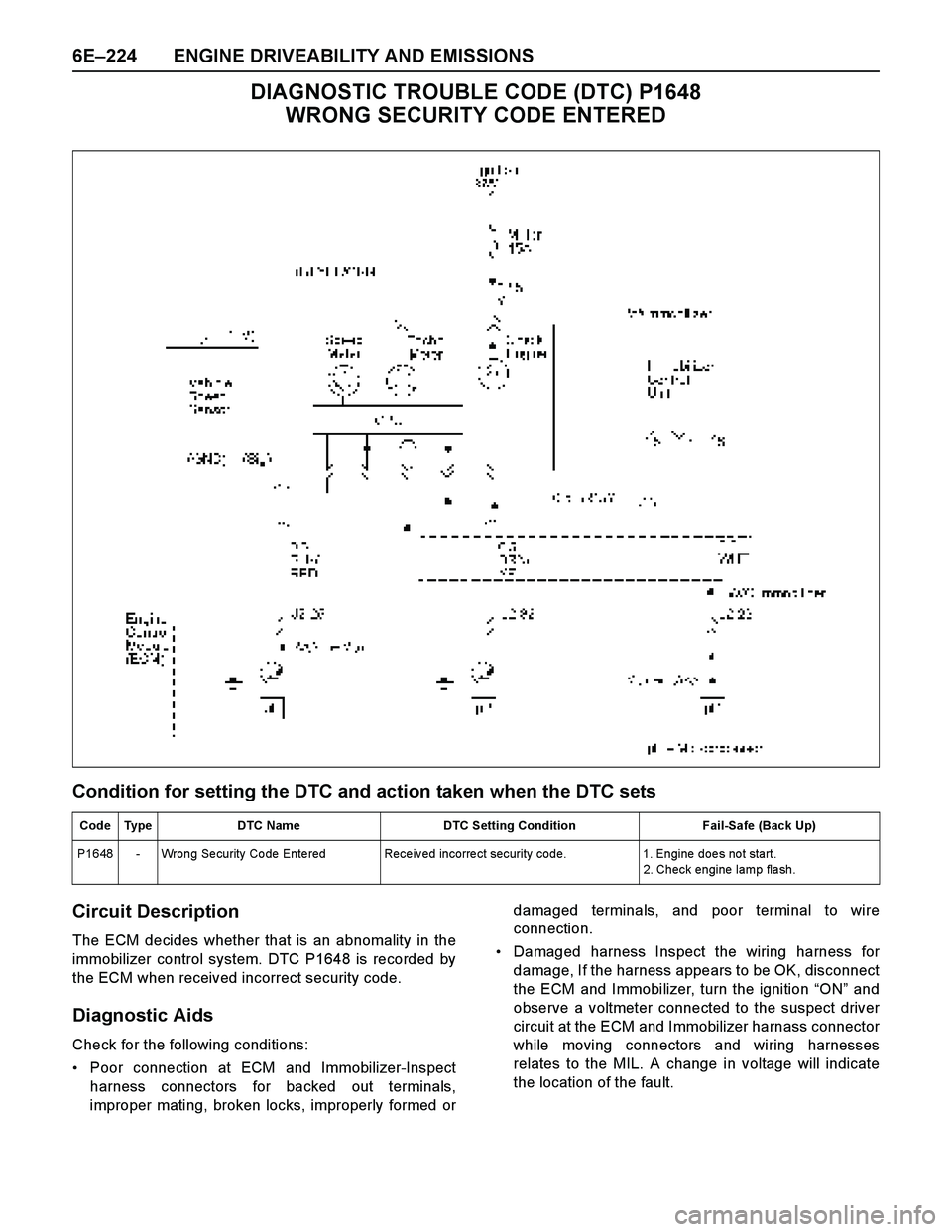
6E–224 ENGINE DRIVEABILITY AND EMISSIONS
DIAGNOSTIC TROUBLE CODE (DTC) P1648
WRONG SECURITY CODE ENTERED
Condition for setting the DTC and action taken when the DTC sets
Circuit Description
The ECM decides whether that is an abnomality in the
immobilizer control system. DTC P1648 is recorded by
the ECM when received incorrect security code.
Diagnostic Aids
Check for the following conditions:
Poor connection at ECM and Immobilizer-Inspect
harness connectors for backed out terminals,
improper mating, broken locks, improperly formed ordamaged terminals, and poor terminal to wire
connection.
Damaged harness Inspect the wiring harness for
damage, If the harness appears to be OK, disconnect
the ECM and Immobilizer, turn the ignition “ON” and
observe a voltmeter connected to the suspect driver
circuit at the ECM and Immobilizer harnass connector
while moving connectors and wiring harnesses
relates to the MIL. A change in voltage will indicate
the location of the fault.
Code Type DTC Name DTC Setting Condition Fail-Safe (Back Up)
P1648 - Wrong Security Code Entered Received incorrect security code. 1. Engine does not start.
2. Check engine lamp flash.
Page 2802 of 4264
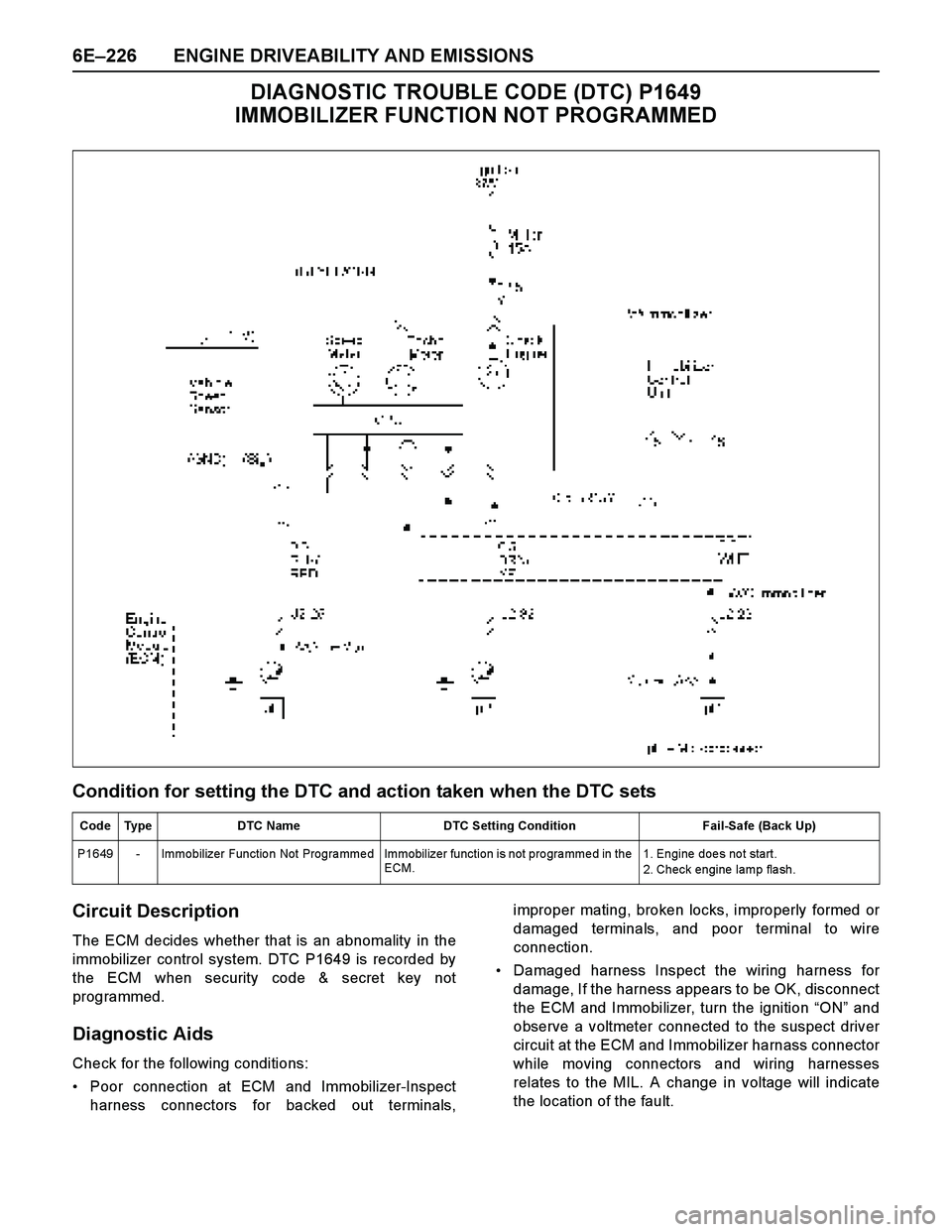
6E–226 ENGINE DRIVEABILITY AND EMISSIONS
DIAGNOSTIC TROUBLE CODE (DTC) P1649
IMMOBILIZER FUNCTION NOT PROGRAMMED
Condition for setting the DTC and action taken when the DTC sets
Circuit Description
The ECM decides whether that is an abnomality in the
immobilizer control system. DTC P1649 is recorded by
the ECM when security code & secret key not
programmed.
Diagnostic Aids
Check for the following conditions:
Poor connection at ECM and Immobilizer-Inspect
harness connectors for backed out terminals,improper mating, broken locks, improperly formed or
damaged terminals, and poor terminal to wire
connection.
Damaged harness Inspect the wiring harness for
damage, If the harness appears to be OK, disconnect
the ECM and Immobilizer, turn the ignition “ON” and
observe a voltmeter connected to the suspect driver
circuit at the ECM and Immobilizer harnass connector
while moving connectors and wiring harnesses
relates to the MIL. A change in voltage will indicate
the location of the fault.
Code Type DTC Name DTC Setting Condition Fail-Safe (Back Up)
P1649 - Immobilizer Function Not Programmed Immobilizer function is not programmed in the
ECM.1. Engine doe s no t start.
2. Check engine lamp flash.